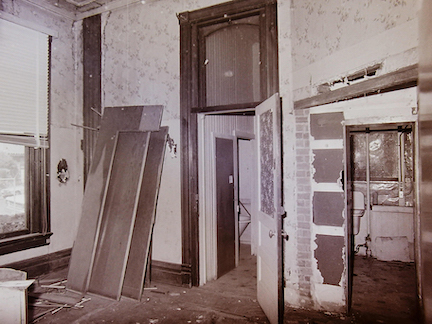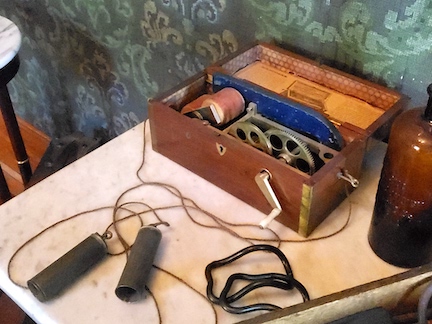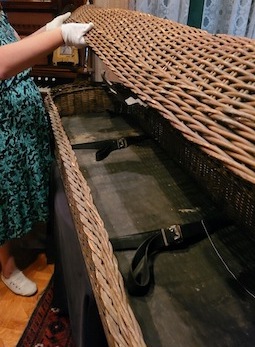The Doctor’s Office
 Through the interview with Jessie Jean (Higley) Lane, we know that her father, S.W. Higley, used this room as an office, and that he had a large, roll-top desk. We also believe that Dr. Rosson used this room to see patients during the brief time he and his family lived in the home, as his practice was listed at this address in the 1895 Phoenix City Directory. But when the Gammel family lived in the house (1914-1948), they needed to rent out rooms in the House, and they moved their bedrooms downstairs – their daughters used the family parlor as a bedroom while Frankie and Billy Gammel used the office as a bedroom.
Through the interview with Jessie Jean (Higley) Lane, we know that her father, S.W. Higley, used this room as an office, and that he had a large, roll-top desk. We also believe that Dr. Rosson used this room to see patients during the brief time he and his family lived in the home, as his practice was listed at this address in the 1895 Phoenix City Directory. But when the Gammel family lived in the house (1914-1948), they needed to rent out rooms in the House, and they moved their bedrooms downstairs – their daughters used the family parlor as a bedroom while Frankie and Billy Gammel used the office as a bedroom.
In this room you can see the chase boards that follow the plumbing/pipes down from the bathroom directly above. There is a corner closet, and a vertical pocket door accessing the back porch. The flooring border in this room is a combination of the border from the entryway, the hallway, and the family parlor – whether this was on purpose or an accident of not ordering enough of the correct flooring, we don’t know! During restoration, part of the pressed metal ceiling in the doctor’s office was salvaged to replace the ceiling in the sewing area (second floor landing). It was replaced with a period-accurate ceiling was that was purchased in Ohio.
There are many interesting artifacts in this room that visitors want to know more about. Here are a few of our favorites, in alphabetical order (if there are any we’ve missed that you’d like to know more about, please let us know):
-
Anatomy Chart
 Printing across the bottom reads, “White’s Physiological Manikin / James T. White & Co. Publishers New York and London.” Printing on the left reads, “Patented May 18, 1886, March 26, 1889.” This is a life-sized, full-color anatomical chart consisting of basic images with multiple superimposed hinged flaps. In 1884, James Terry White of San Francisco invented this anatomy chart, and he sold over 50,000 of them to schools and doctors.
Printing across the bottom reads, “White’s Physiological Manikin / James T. White & Co. Publishers New York and London.” Printing on the left reads, “Patented May 18, 1886, March 26, 1889.” This is a life-sized, full-color anatomical chart consisting of basic images with multiple superimposed hinged flaps. In 1884, James Terry White of San Francisco invented this anatomy chart, and he sold over 50,000 of them to schools and doctors.
-
Atomizer
A medical device used to reduce liquids to a fine spray. This atomizer is made of tin and was identified by a medical historian as an apparatus used specifically to help anesthetize or numb the throat and indicated that small atomizers like this often used cocaine as a numbing agent.
-
Autoclave or Sterilizer
 Made by the Wilmot Castle & Co. Rochester, NY, the front is embossed with, “The Arnold Steam Sterilizer/Pat. May 9. 82.” Though a French physicist discovered in 1680 that hot water and steam cleaned objects thoroughly, it wasn’t until the 1880s that sterilization of surgical and medical tools was widespread.
Made by the Wilmot Castle & Co. Rochester, NY, the front is embossed with, “The Arnold Steam Sterilizer/Pat. May 9. 82.” Though a French physicist discovered in 1680 that hot water and steam cleaned objects thoroughly, it wasn’t until the 1880s that sterilization of surgical and medical tools was widespread.
-
Cooling Board
Near the handle is a small brass black that reads, “The Climax / Made by the Enterprise MFG Co/ Columbus, Ohio.” When someone died, cooling boards were used to cool their body for a mortician or during a viewing. The deceased was placed on the cooling board, blocks of ice were placed under the table to keep the body cool.
-
Electrotherapy Machine
 “Hall’s Portable Magnetic Machine for Nervous Diseases,” c1860s-1870s. The price on printed material inside machine indicates it was sold for $10. Mild electric shocks were a popular treatment for many maladies during the 19th century, from treatments of “hysteria” and problems with virility, to migraines and upset stomachs. A crank was turned to generate electricity with a magnet, and the strength of the electric shock depended on how fast the crank was turned. The metal terminals (attached to the crank with wires) were placed on the part of the body needing treatment.
“Hall’s Portable Magnetic Machine for Nervous Diseases,” c1860s-1870s. The price on printed material inside machine indicates it was sold for $10. Mild electric shocks were a popular treatment for many maladies during the 19th century, from treatments of “hysteria” and problems with virility, to migraines and upset stomachs. A crank was turned to generate electricity with a magnet, and the strength of the electric shock depended on how fast the crank was turned. The metal terminals (attached to the crank with wires) were placed on the part of the body needing treatment.
-
Sphygmomanometer or Blood Pressure Machine
Pilling Special Sphygmomanometer, c1910. Housed in an oak box with a glass bulb, with rubber pressure tubing and bulb. The first device to record blood pressure was invented in 1881, but the modern method of measuring both systolic and diastolic blood pressure levels wasn’t developed until 1905.
-
Wicker Casket
 Wicker caskets (also known as transfer caskets) were once used as a reusable, temporary caskets to transport the deceased from their homes, and sometimes as caskets for viewings (it kept the body cooler because the wicker allowed for airflow). We acquired this casket from the permanently closed Phoenix Museum of History. According to their documentation, it dates from the 1920s and was used to transport bodies from their place of death to A.L. Moore and Sons Mortuary. The mortuary was established in 1909 in Phoenix on the south side of Adams St. between 3rd and 4th Avenues, and was owned by the family until the 1980s. The building was condemned in 1996 and this is now the location of the Phoenix Municipal Court building.
Wicker caskets (also known as transfer caskets) were once used as a reusable, temporary caskets to transport the deceased from their homes, and sometimes as caskets for viewings (it kept the body cooler because the wicker allowed for airflow). We acquired this casket from the permanently closed Phoenix Museum of History. According to their documentation, it dates from the 1920s and was used to transport bodies from their place of death to A.L. Moore and Sons Mortuary. The mortuary was established in 1909 in Phoenix on the south side of Adams St. between 3rd and 4th Avenues, and was owned by the family until the 1980s. The building was condemned in 1996 and this is now the location of the Phoenix Municipal Court building.
-
Wooton Desk
Patented October 6, 1874 by Rev. William Wooton, and manufactured by the Wooton Desk Company of Indianapolis, IN. Wooton desks are essentially elaborate, self-contained offices that feature foldable desks, mail slots, shelves, drawers, pigeon-holes, and sometimes even hidden compartments. Our Wooten desk is made from walnut with burled walnut veneer panels on exterior and maple and walnut shelves on interior. It was donated as belonging to the first postmaster of Baltimore, MD.
Learn more about Dr. Rosson and his life from our blog article, We’re No Angels. Explore the dangerous side of medicine in our articles, Victorian Cures & Quacks, and Victorian Killers. Find out how communicable diseases have affected schools and businesses throughout our nation’s history in our article, School’s Out. And finally, discover more about electricity during the 19th century (for medical use and otherwise) in our article, It’s Electric.
El Consultorio Médico
 Por medio de la entrevista con Jessie Jean (Higley) Lane, sabemos que su padre, S.W. Higley, utilizó esta habitación como oficina, y que tenía un gran escritorio de persiana. También creemos que el Dr. Rosson utilizó esta habitación para atender a pacientes durante el breve periodo en el que él y su familia vivieron en la casa, ya que su práctica medica estaba registrar en esta dirección en el Directorio de la Ciudad de Phoenix en 1895. Sin embargo, cuando la familia Gammel vivió en la casa (1914-1948), necesitaban rentar varias habitaciones en la casa, y reubicaron sus recámaras al primer piso – sus hijas utilizaron el salón familiar como su dormitorio, mientras que Frankie y Billy Gammel utilizaron la oficina como su recámara.
Por medio de la entrevista con Jessie Jean (Higley) Lane, sabemos que su padre, S.W. Higley, utilizó esta habitación como oficina, y que tenía un gran escritorio de persiana. También creemos que el Dr. Rosson utilizó esta habitación para atender a pacientes durante el breve periodo en el que él y su familia vivieron en la casa, ya que su práctica medica estaba registrar en esta dirección en el Directorio de la Ciudad de Phoenix en 1895. Sin embargo, cuando la familia Gammel vivió en la casa (1914-1948), necesitaban rentar varias habitaciones en la casa, y reubicaron sus recámaras al primer piso – sus hijas utilizaron el salón familiar como su dormitorio, mientras que Frankie y Billy Gammel utilizaron la oficina como su recámara.
En este cuarto pueden ver los tablones de alcance que siguen la dirección de la tubería desde el baño directamente sobre éste. Hay un armario en la esquina, y una puerta corrediza con acceso al porche trasero. Los márgenes del piso en esta habitación cuenta con una combinación de los márgenes de la entrada, el pasillo, y el salón familiar – si esto fue a propósito o un accidente por no pedir suficiente material del piso correcto, ¡no lo sabemos! Durante la restauración, parte del techo de hojalata prensada en el consultorio médico fue recuperado para reemplazar el techo en el área de costura (rellano del segundo piso). Fue reemplazado con techo del periodo que se adquirió en Ohio.
Hay muchos artefactos interesantes en esta habitación sobre los que los visitantes quieren saber más. Aquí están algunos de nuestros favoritos, en orden alfabético (si hay alguno que no hemos incluido y quisieras saber más acerca de él, háganoslo saber):
-
Ataúd de Mimbre
 Los ataúdes de mimbre (también conocidos como ataúdes de transferencia) alguna vez se utilizaron como ataúdes reutilizables y temporales para transportar al difunto de su hogar, y a veces como ataúdes para velorio (mantenía el cuerpo fresco ya que el mimbre permite el flujo de aire). Adquirimos este ataúd del Museo de Historia de Phoenix, el que ha sido permanentemente cerrado. De acuerdo con su documentación, data de los 1920s y fue utilizado para transportar cuerpos de su lugar de fallecimiento a la funeraria de L. Moore e Hijos. La funeraria fue establecida el 1909 en Phoenix en el lado sur de la calle Adams entre la 3ra y 4ta Avenida, y fue propiedad de la familia hasta los 1908s. El edificio fue and was owned by the family until the 1980s. El edificio fue condenado en 1996 y es ahora la ubicación del edificio de la Corte Municipal de Phoenix.
Los ataúdes de mimbre (también conocidos como ataúdes de transferencia) alguna vez se utilizaron como ataúdes reutilizables y temporales para transportar al difunto de su hogar, y a veces como ataúdes para velorio (mantenía el cuerpo fresco ya que el mimbre permite el flujo de aire). Adquirimos este ataúd del Museo de Historia de Phoenix, el que ha sido permanentemente cerrado. De acuerdo con su documentación, data de los 1920s y fue utilizado para transportar cuerpos de su lugar de fallecimiento a la funeraria de L. Moore e Hijos. La funeraria fue establecida el 1909 en Phoenix en el lado sur de la calle Adams entre la 3ra y 4ta Avenida, y fue propiedad de la familia hasta los 1908s. El edificio fue and was owned by the family until the 1980s. El edificio fue condenado en 1996 y es ahora la ubicación del edificio de la Corte Municipal de Phoenix.
-
Autoclave or Esterilizador
 Hecho por Wilmot Castle & Co. Rochester, NY, la parte delantera está grabada con “El Esterilizador de Vapor Arnold/Pat. Mayo 9. 82.” Mientras que un médico francés descubrió en 1680 que el agua caliente y el vapor limpiaban objetos meticulosamente, fue hasta los 1880s que la esterilización de instrumentos quirúrgicos y médicos se hizo común.
Hecho por Wilmot Castle & Co. Rochester, NY, la parte delantera está grabada con “El Esterilizador de Vapor Arnold/Pat. Mayo 9. 82.” Mientras que un médico francés descubrió en 1680 que el agua caliente y el vapor limpiaban objetos meticulosamente, fue hasta los 1880s que la esterilización de instrumentos quirúrgicos y médicos se hizo común.
-
Escritorio Wooton
Patentado el 6 de octubre de 1874 por el Reverendo William Wooton, y fabricado por la Compañía de Escritorio Wooton de Indianapolis, IN. Los Escritorios Wooton son esencialmente oficinas independientes que cuentan con escritorios plegables, espacios para correo, estantes, cajones, casilleros y a veces compartimientos secretos. Nuestro escritorio Wooten pigeon-holes, está hecho de nogal con paneles de chapa de nogal moteado en el exterior y estantes de maple y nogal en el interior. Fue donado como pertenencia del primer administrador de correos de Baltimore, MD.
-
Esfigmomanómetro o Máquina de Presión Arterial
Esfigmomanómetro Especial Pilling, c1910. Alojado en una caja de roble con una bombilla de vidrio y un tubo y bombilla de caucho para la presión. El primer dispositivo para registrar la presión arterial fue inventado en 1881, pero el método moderno de medir ambas presiones arteriales sistólicas y diastólicas no se desarrolló hasta 1905.
-
Máquina de Electroterapia
 “Máquina Magnética Portátil Hall para Enfermedades nerviosas,” c1860s-1870s. El precio en el material impreso dentro de la máquina indica que fue vendido por $10. Leves descargas eléctricas eran un tratamiento popular para muchas enfermedades en el sigo 19, desde tratamientos para la “histeria” y problemas con virilidad, de migrañas a malestar estomacal. Una manivela se movía para generar electricidad con un imán y la fuerza de la descarga eléctrica dependía de qué tan rápido podías mover la manivela. Las terminales de metal (unidas a la manivela con cables) se colocaban en la parte del cuerpo que requiriera tratamiento.
“Máquina Magnética Portátil Hall para Enfermedades nerviosas,” c1860s-1870s. El precio en el material impreso dentro de la máquina indica que fue vendido por $10. Leves descargas eléctricas eran un tratamiento popular para muchas enfermedades en el sigo 19, desde tratamientos para la “histeria” y problemas con virilidad, de migrañas a malestar estomacal. Una manivela se movía para generar electricidad con un imán y la fuerza de la descarga eléctrica dependía de qué tan rápido podías mover la manivela. Las terminales de metal (unidas a la manivela con cables) se colocaban en la parte del cuerpo que requiriera tratamiento.
-
Tabla de Anatomía
 La impresión en la parte inferior dice “Maniquí fisiológico de White / James T. White & Co. Editores Nueva York y Londres.” La impresión del lado izquierdo dice, “Patentado el 18 de Mayo, 1886, Marzo 26, 1889.” Esta es una tabla anatómica de tamaño natural y a color que consiste en imágenes básicas con múltiples hojas plegadizas sobrepuestas. En 1884, James Terry White de San Francisco inventó esta tabla de anatomía, y vendió más de 50,000 de ellas a escuelas y doctores.
La impresión en la parte inferior dice “Maniquí fisiológico de White / James T. White & Co. Editores Nueva York y Londres.” La impresión del lado izquierdo dice, “Patentado el 18 de Mayo, 1886, Marzo 26, 1889.” Esta es una tabla anatómica de tamaño natural y a color que consiste en imágenes básicas con múltiples hojas plegadizas sobrepuestas. En 1884, James Terry White de San Francisco inventó esta tabla de anatomía, y vendió más de 50,000 de ellas a escuelas y doctores.
-
Tabla de Enfriamiento
Cerca de la manija se encuentra una pequeña placa de latón que dice, “El Climax / Hecho por Enterprise MFG Co/ Columbus, Ohio.” Cuando alguien fallecía, las tablas de enfriamiento se utilizaban para enfriar o refrescar el cuerpo para una funeraria o durante un velorio. El difunto se colocaba sobre la tabla de enfriamiento y bloques de hielo se colocaban bajo la tabla para mantener el cuerpo helado.
Aprende más acerca del Dr. Rosson y su vida de nuestro artículo de blog, We’re No Angels (No Somos Ángeles). Explora el lado peligroso de la medicina en nuestros artículos Victorian Cures & Quacks (Curas y Charlatanes Victorianos), y Victorian Killers (Asesinos Victorianos). Conoce cómo las enfermedades contagiosas han afectado a escuelas y negocios a lo largo de la historia de nuestra nación en nuestro artículo School’s Out (Se Acabó la Escuela). Y finalmente, descubre más acerca de la electricidad en el siglo 19 (para uso médico y demás) en nuestro artículo, It’s Electric (Es Eléctrico).
